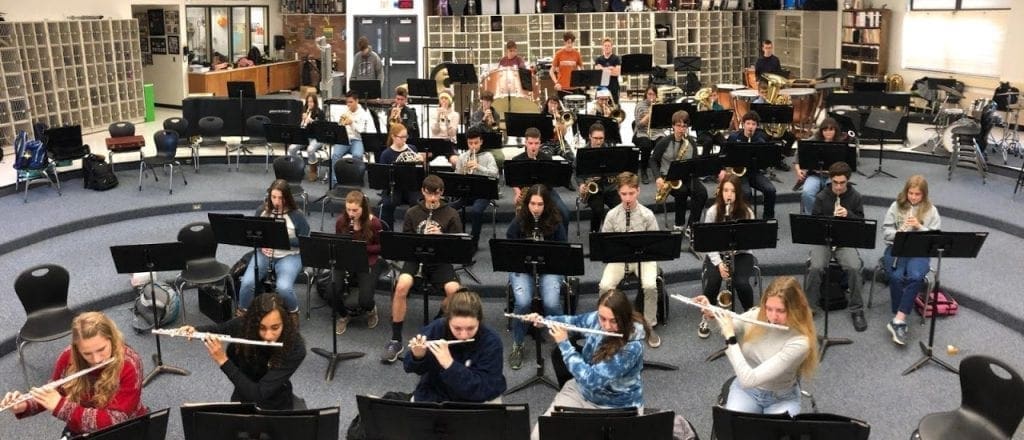
A 2019-2020 Band Rehearsal. Credit: SH Music Department
Musicians During a Pandemic: It’s Been Tough
Going from concerts every few months to rehearsals every few days has been tough. Read how COVID has affected musicians and their day to day rehearsals.
Throughout the pandemic almost all of us have pondered the feelings and emotions of students, teachers, parents and athletes. However, have you considered what it is like for musicians? Having such a skill and trying to learn more and advance at your talent is difficult as it is. But during the pandemic, musicians haven’t been so lucky.
Music classes before COVID hit were as you would imagine. Go to class, take out instruments, tune instruments, warmup, rehearse, and put away instruments. A similar procedure would occur during lessons as well. Classes five days a week with a lesson once a week. Musicians would also have concerts and performances throughout the year. This year however, new restrictions have been introduced to reduce the spread of COVID and that makes things very different.
One of these differences would be the schedule. To follow the new restrictions, Sweet Home introduced a hybrid model for school. The hybrid model only allows students to attend school two days a week for 30 minute class periods. By the time a musician gets ready and has gone through warmups, most of the class period is already gone. New restrictions also made it so musicians have to be spread apart 6 feet in an awkward arrangement. Classes are at approximately 40 percent occupancy. This separation and lack of other musicians makes it difficult to sound your best.
Another struggle for musicians was the switch to remote. For roughly 2 months the high school switched to remote learning. I don’t think many people thought about how this could affect kids involved in a music group. Being all online means calls where the audio won’t match up if everyone is playing or singing at once and it was a very awkward situation. Teacher’s did their best attempting to make the most of class time, but the switch to remote really put musicians in a position where learning and getting better was all on themselves without much guidance.
Having this responsibility of getting better on your own and only getting one lesson per week to get more practice with instruction is difficult. As an orchestra player, I feel being part of the hybrid model is good in some way because we can be together at least two days a week, even if it’s only less than half of the orchestra. For me, hearing other people playing is a big part of rehearsing. The inability to hear others while rehearsing I think is why being remote was so tough. During the remote period my orchestra teacher, Mr. Marone, played the official track to the song we were playing and everyone would mute and play by themselves. We couldn’t do much else other than individuals unmuting and playing a section. One issue with rehearsing via a remote meeting is sound. The internet connection during meetings can be unstable and the sound does not come across the same as in-person. You can sound out of tune, too quiet, or the sound may not match with the image.
I obviously can’t speak for everyone, but the situations tend to remain the same between the different ensembles. Bella Bowman, a ninth grade chorus member describes her online classes as really glitchy and rough overall. During this online period, chorus members had to mute their mics like orchestra and had to sing on their own. It was very hard on the singers because they are used to a group performance. As for the days in-person, Bella said, “[these new rules] affect me and many others because we can’t sing our best with masks on. It is very difficult to breathe well with the masks on.” As you can imagine, this is very difficult for musicians trying to keep up with their talent and abiding by the rules.
Now teacher’s have a different viewpoint on this situation, but they still have to follow the same guidelines as everyone else. Mr. Marone, the high school orchestra teacher, directs the symphony and concert orchestra. When I asked him about the challenges and how it’s been, he said teaching such a “hands on” class during a time like this is extremely challenging. He explained that with shorter periods, and hybrid blue and gold days, music groups are operating at less than 40% of the normal time than a regular school year would have. With social distancing, reduced numbers, and some completely virtual students, it is even more difficult for students to grow as musicians, the ensemble to develop, and sustain the program. The motivation also is not there because there is no concert deadline that students are striving for. In his words, “The lack of consistency, (starting the school year hybrid, going fully remote, back to hybrid) has also created another complete set of challenges. I think both students and teachers are being forced to really think creatively, adapt to our ever-changing situation, and to find the internal motivation to keep going.”
In conclusion, this past year has been super challenging for all types of students. If you are in music or not, I think we can all agree it has been very difficult for these students to be musicians. There is not much we can do to change the current situation, but remember that this is temporary. In the future we will be able to come together and perform like before! Stay safe!

Maddie is a freshman this year and is new to the Panther Eye. She is eager to start this year and help out writing about a lot of topics.

